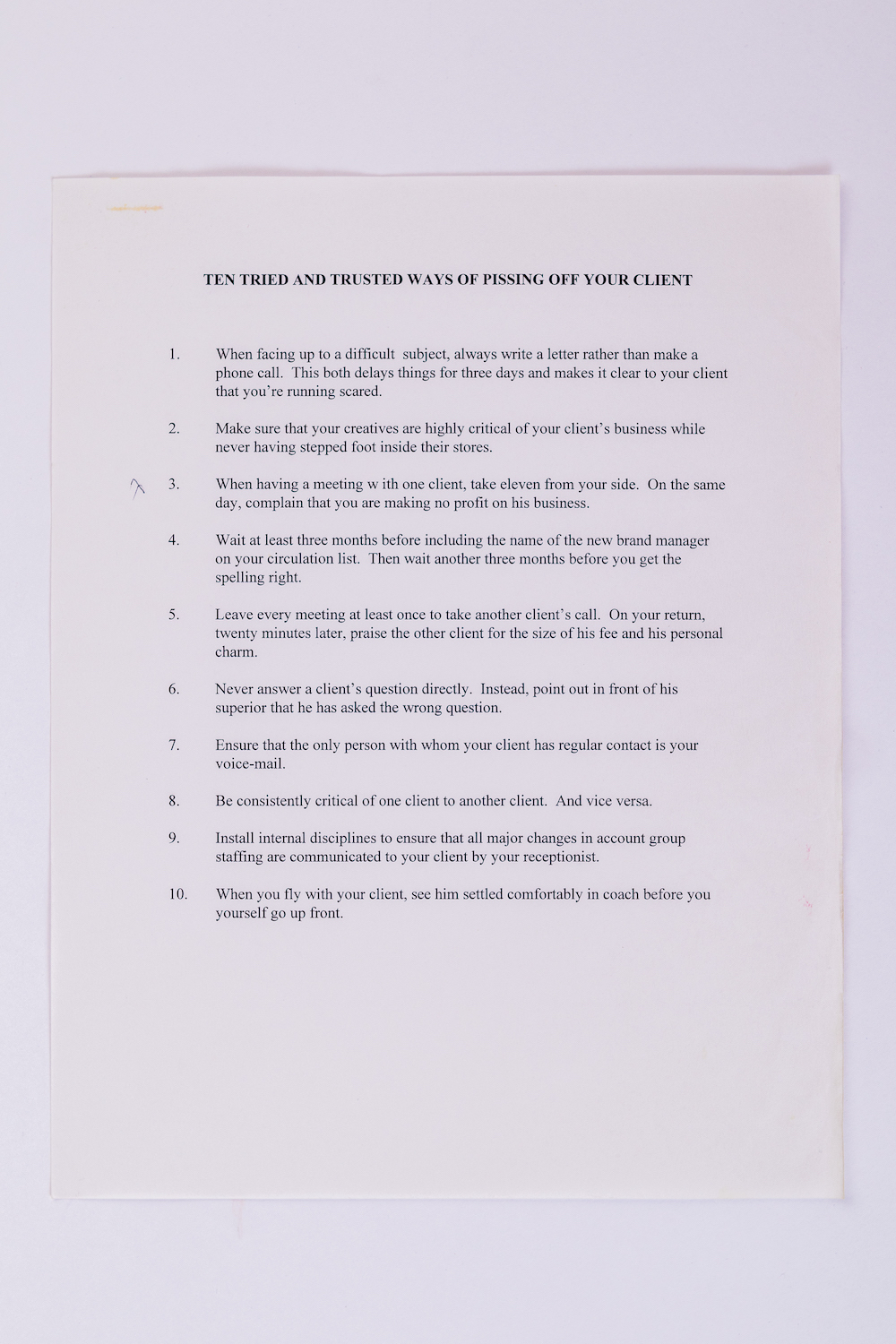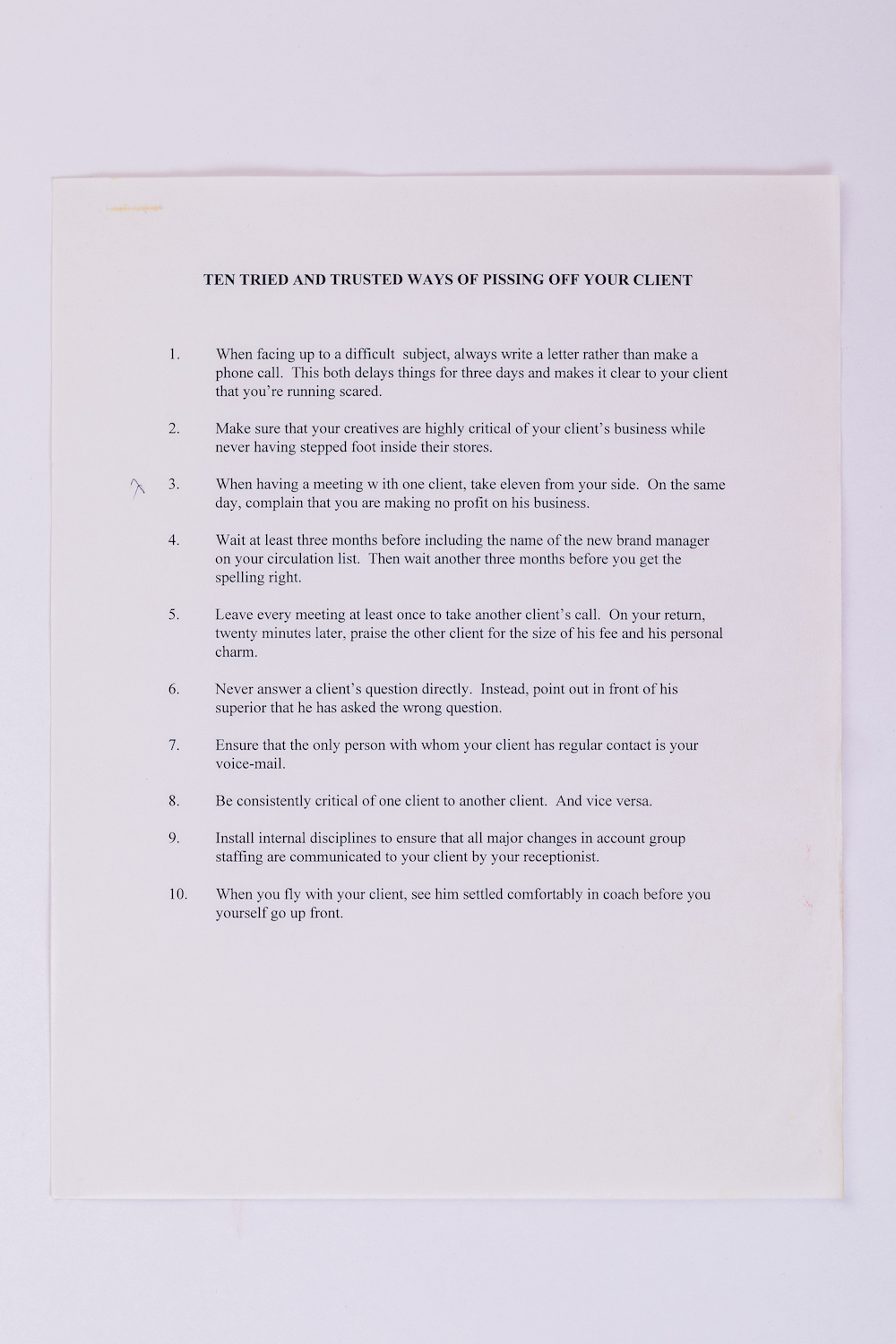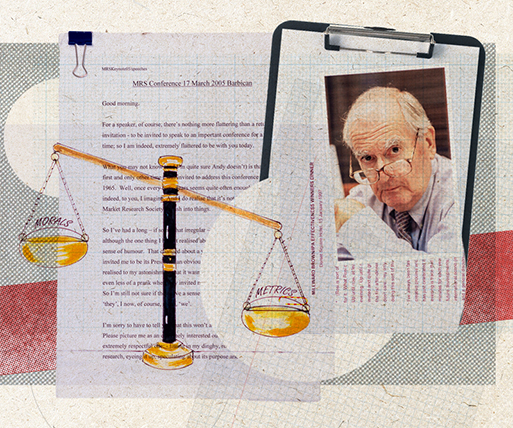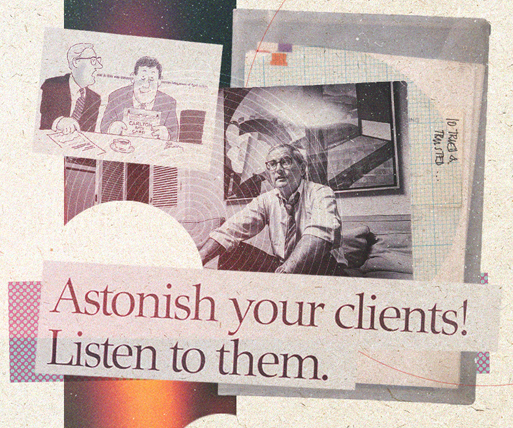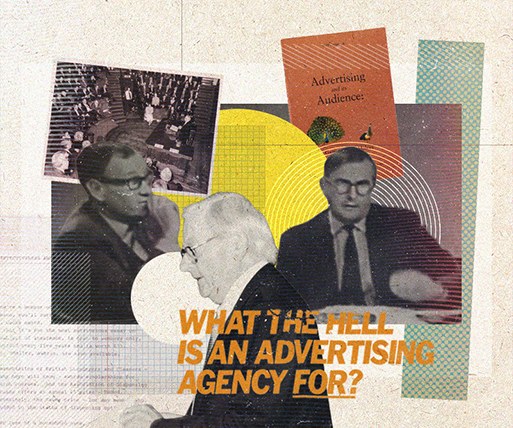Ten tried and trusted …
- Date: 2000
- Publisher: JWT/WPP
- PEOPLE
Jeremy observed that “almost all deeply serious rifts in client/agency relationships are precipitated by deeply trivial causes”. So he delivered his serious thoughts on the topic via a light-hearted presentation: ‘Ten tried and trusted ways of getting the least from your advertising agency’ and ‘Ten tried and trusted ways of pissing off your client’. Witty and incisive, tailored versions found an appreciative audience from New Delhi to New York.
The client to whom Jeremy first gave this presentation was not a client at all, but a prospective client. Many, many years later – and he still was. There may be a lesson in there somewhere.
Speech: attached
TEN TRIED-AND-TRUSTED WAYS OF GETTING THE LEAST FROM YOUR ADVERTISING AGENCY
16 May 2000 - Pennyhill Park
I used to be asked by clients to make lots of presentations about client/agency relationships.
I think they asked me mainly so that they could pride themselves on having an open, self-critical approach to doing business with suppliers while continuing to treat them with their habitual contempt.
After a few hundred presentations of this kind, I got tired of talking about commitment and professionalism and partnership and mother love and shared goals - so when I was invited one more time, I invented a new presentation called Ten Tried and Trusted Ways of Getting the Least From Your Advertising Agency. And that’s what’s coming up any minute.
I’ve got four points to make about it: two beforehand and two afterwards.
I’m very conscious that it was written from the perspective of an advertising agency and that most of you here this evening are from disciplines other than advertising. I hope that some of it, at least, will still seem relevant to most of you.
You’ll find most of it extremely trivial. And that’s because, in my experience, almost all deeply serious rifts in client/agency relationships are precipitated by deeply trivial causes.
So, for the next half-hour or so: you are now clients:
What I intend to do is take you through, one by one, my Ten Tried and-Trusted Ways of Getting the Least from Your Advertising Agency - every one of which I have personally experienced and can warmly recommend. You should know that, to date, no client, however dedicated, has mastered all ten. I hope you see this as a challenge. If you listen carefully and take notes, you could be the first client in the world to pull off the grand slam and reduce your agency to both incoherence and bankruptcy.
QNE: KEEP THEM FEELING INSECURE
Advertising agencies, even big ones, are very small businesses. If they’re any good, they’ll have on their payroll an unusual number of sensitive, talented, fallible, competitive and insecure people. Most of them will be motivated not by money but by interest in using their skills to help you the client be more successful.
By not trusting your agency, you can instantly put a stop to all such foolish nonsense.
An effective stratagem is to let it be known that you are visiting other agencies. Not seriously, of course: you’re just doing your job by keeping in touch with the marketplace. An added touch is to allow the news of your visits to reach your incumbent agency through the pages of the trade press.
Your agency, being human, will immediately devote all its efforts to pleasing you rather than trying to find profitable solutions to your marketing problems.
All marketing service companies are insecure - and if they aren’t, they ought to be. Any sign of complacency in your agency can usually be corrected by a short, sharp phone call.
But that would be sensible. Far more effective to increase their sense of insecurity to one of mindless dither.
TWO: KEEP_THEM IN THE DARK
Remind your agency that you have a fully staffed, highly professional marketing department and that all you need from them is some ads. (The word “adverts'” can be recommended here). This technique means that you can now legitimately withhold from your agency such irrelevant information as sales figures, research data and competitive activity.
However conscientious your agency, this decision can be guaranteed to encourage irrelevant advertising.
It will also deny you access to anyone in the agency who might just have been able to help you with your marketing strategy, and force the agency to evaluate its own work on some vacuous scale of creativity. Not bad: in just one move, you screw up the relationship and fail to get value for your agency fees.
THREE: EMPLOY AT LEAST ONE INCOMPETENT, UNDERWORKED JUNIOR
These words are carefully chosen. He or she must be all these things: incompetent, underworked and junior - otherwise this technique has been known to fail.
His job (or to be more accurate, his non-job) is to waste your agency’s time. He is always in the agency- because in the agency, he feels important whereas back in his own office he feels little more than an incompetent, underworked junior.
Ideally he (or she: I wouldn't like you to think that this is a job that only men can do) should have a slightly ridiculous name, such as Beverley - so that the agency group can say, “Oh, Christ. Beverley’s in again and wants lunch.”
A really incompetent Beverley will not only waste the agency’s time but will actively mislead them. He will gossip continually- about his superiors, their rivalries, what they really think of the agency; and what they thought of the other agencies that they haven’t been seeing.
Naturally, any agency with courage, principles and a sound relationship with a more senior client will soon make it clear that Beverley is doing far more harm than good. Equally naturally, the client, who has been to management school and knows the importance of backing your own people, will defend Beverley. Also that week, by sheer chance, the agency will go way over budget on a key commercial and send in its first inaccurate invoice for two years.
The agency will immediately find itself on the defensive; the senior client will question Beverley closely about his views of the agency; Beverley will say that they always need to be kept on their toes (that’s why he has to spend so much time with them): - and another close and fruitful partnership will begin to disintegrate.
No client with serious ambitions to be bad can afford to be without a Beverley.
FOUR: TELL DIFFERENT PEOPLE DIFFERENT THINGS
This is all the more effective if you have a highly structured and hierarchical marketing department, the value of which I shall return to later. It also helps if you are part of a multi-national company. This enables you, as international marketing director, to tell the management of your agency that what you want is work that Chuck Rebozo will understand back in Grand Rapids, Michigan. While at exactly the same time, your marketing manager is telling the account executive: the hell with Chuck Rebozo - what he wants is advertising that will shift product in the Philippines.
Another small tip here: Tell your agency that you are deeply suspicious of advertising that wins awards: - while letting it be known, preferably through Beverley, that you are mildly disappointed that the work they do for you never does.
FIVE: NEVER PUT THE TRUTH IN WRITING
I realise that this comes naturally to many clients, but it deserves a place. Write a letter after the first presentation of the creative material congratulating the agency on its fresh and stimulating approach and encouraging them to develop it. At the same time instigate a series of internal discussions designed to spread unease and uncertainty amongst your own people. Three particular phrases are worth bearing in mind here: “Creativity for its own sake……”“Certainly all in favour of originality, but...” And: “I can't help wondering what Chuck Rebozo will make of it.” Ideally, these sentences should never be finished - just allowed to hang indefinitely in the air.
When asked at the annual agency/ client review your opinion of the account group, reply, in writing, “Absolutely first-class.” Within a month, tell the agency CEO that you want a word with him on the subject of staffing.
SIX: NEVER ADMIT TO A MISTAKE
This technique has two advantages. First, it keeps your own record clean: important if you are at all ambitious. And even more valuably, it means that your agency will soon adopt the same practice and never admit to a mistake either.
As we all know, the best creative work emerges from a totally open and honest assessment of the brand’s strengths and weaknesses and general agreement on past errors and omissions. By neither side ever admitting to a mistake, this kind of constructive discussion becomes impossible. Mistakes, instead of being swiftly recognised and rectified, are perpetuated; and you should be able to look forward to inferior and irrelevant work more or less for ever.
SEVEN: CHANGE YOUR MAIN CONTACT WITH THE AGENCY AT LEAST ONCE A YEAR
This can often be achieved without even trying, but check that you aren’t inadvertently allowing really fruitful professional relationships to take root. Simultaneously, insist that your agency maintains complete stability at their end. This will ensure that only stale minds are brought to bear on your problem.
After three years and four brand managers from your side, you should be able to review the work on your brands and demonstrate a sad lack of consistency. This is obviously the time to demand an entirely new agency group - which in turn will guarantee you a fifth change in brand strategy.
This is a critical technique. When mastered, it can destroy not only your agency but also your most profitable brands.
EIGHT: NEVER SAY THANK YOU
As I’m sure you know, most good agency people are fuelled and re fuelled mainly by gratitude, encouragement and appreciation.
A word of advice: starve them of it.
It should always be too early to say thank-you - or too late.
One hand-written letter saying thank-you to your account executive or creative director could bring you enough enthusiasm and commitment to keep up a flow of outstanding work for at least another year - and what really bad client wants that, for God’s sake?
This next one is far more important than it may seem.
NINE: NEVER PAY FOR A DRINK
This simple trick is valuable in two significant ways.
First, it confirms the agency’s view of your essential mean spiritedness - always a worthwhile achievement.
And second, by never buying a drink, you continue to make clear your fundamental view of the agency/client relationship. None of this partnership rubbish we hear so much about. The relationship is one of principal and supplier - master and servant.
The function of a supplier, it stands to reason, is quite simply to supply: ideas, advertisements, specially designed birthday cards for your chairman’s wife. And drinks.
Since a supplier is by definition inferior to a principal, why should you waste your company’s money buying drinks for inferiors? And if you did buy them a drink, they might begin to think that you quite liked them or appreciated them or something - and we all know what that could lead to. The same old trap: good work.
And finally:
TEN: INSTALL A HIGHLY COMPLEX, HIERARCHICAL APPROVAL SYSTEM.
Naturally, you can only be certain of what sort of system to adopt if you first understand how good creative work can sometimes slip through by mistake.
As we all understand, good work is most likely to be produced by a combination of shared and disciplined thinking about strategy; and the undisciplined, unfettered, uninhibited search for ideas. We also know that, more often than not, it is only in the search for a solution that the true nature of the problem will be fully recognised and understood. In other words, in the creative process, an element of muddle, of experiment, of feedback, of modification, of trial-and error, of mutual trust and a shared excitement in discovery: all these are essential if problem and solution are to be elegantly, successfully reconciled.
Your approval system, therefore, must be ruthlessly devised to see that none of this under any circumstances is possible.
I have two suggestions here. First, insist not only that a communications strategy is written down and agreed- that’s reasonable. Go further: and make it clear that any deviation from that strategy - particularly in the light of new insights emerging - is at all times prohibited.
And second, in your hierarchy of approval, have as many different levels as you can reasonably afford and always start at the bottom.
Naturally enough, Beverley comes in handy here. Because he is 23 and knows nothing about marketing, he must see all the agency’s work first. Vest in him the absolute right to say “no” - but never, of course, allow him to say “yes”.
After he’s sent the work back three times for fundamental revision, he should allow it to be seen by his two superiors. I strongly advise that they should see the work at different times and when one of them is going to be out of the country for the next three weeks so they can’t consult. They can then, separately, send their conflicting views in writing for the agency to consider.
Then I recommend a committee: as large as possible and chaired by the chief executive who has to keep leaving the room to talk to major retailers and financial analysts. Your people - the client people - should sit on one side of the table and the agency people on the other. (A detail I agree, but these things are important.)
Just as important: no one from the client side should admit to having seen the work, let alone to supporting it.
The agency presents. There is a pause. You ask to see it again. There is a longer pause. The chief executive clears his throat and says: “Very interesting. (pause) What do you think, Beverley?”
From that moment on, everything should flow smoothly.
No one is going to say anything that means anything until they know what the chief executive thinks. And the chief executive isn’t going to know what he thinks until he’s heard all the others not saying what they think.
The changes insisted on by Beverley are challenged by the marketing director. Beverley agrees with the marketing director and invites the agency to defend themselves. The sales director says he’s not really qualified to speak on behalf of the consumer but he doesn't think it will go down very well with the sales force who tend to prefer cartoons.
The chief executive sums up. He calls the proposals both challenging and courageous. But because there doesn’t seem to be total unanimity amongst his colleagues, he suggests that two more agency groups should be put to work on the same brief and the three alternatives then submitted to research.....
So there they are, my tried and trusted ten. As you can tell, 30 odd years in the agency business left me a bitter and twisted person.
I said I had two further points to make, and they are these.
The client to whom I first gave this presentation was not a client at all, but a prospective client. Many, many years on - and he still is. There may be a lesson in there somewhere.
And second: we’re now going to get creative.
I have in the past invited clients to make equivalent presentations about the awfulness of agencies and marketing services companies generally and very chastening they often are.
So what I’d like us to do now, between us, using your vast accumulated experience, is compile the ten most tried-and-trusted ways of irritating the hell out of clients. We’ll take notes of the suggestions - and if there’s time tomorrow morning, I’ll let you know the list of winners. (And do remember: the more trivial the offence, the more likely it is to be effective.)
